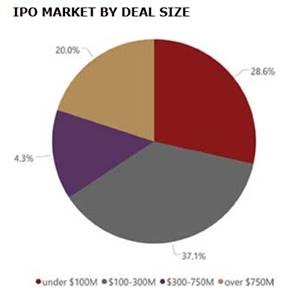NEWS
Small Cap Healthcare Continues to Shine, Aggressive Dual Class Structures Rising in First Half of 2019 According to Paul Hastings’ Going Public: The U.S. IPO Report
November 05, 2019
New report shows that majority of U.S. IPOs were under $300 million, with life sciences and biotech making up the bulk of those offerings.
Dual-class structures also on the rise with a third of issuers adopting multiclass voting structures with aggressive super-voting rights.

New York – A new report on the U.S. IPO market from Paul Hastings LLP, a leading global law firm, shows that despite a number of high-profile public offerings in the first half of 2019, the trend continues to be toward smaller IPOs – those under $300 million – making up 66 percent of all initial public offerings from January through June, with strong IPO pricing and continued use of corporate governance “entrenchment mechanisms” in the first half of the year, each according to Going Public: The U.S. IPO Report.
In Going Public, Paul Hastings conducted a comprehensive review of U.S. IPOs from the first half of 2019, and found that amidst movement by companies to robust private capital markets, evidenced by the high incidence of private placements occurring prior to IPO, IPOs were appropriately marketed at the time of IPO. In fact, over 75 percent of issuers priced at or above the midpoint of the pricing range set before their roadshow. For IPOs $100 million or more, over 85 percent priced at the midpoint or higher.
Interestingly, the relatively strong pricing occurred despite the rise of IPO issuers adopting entrenchment mechanisms such as dual-class structures in which founders or majority shareholders retain high vote stock and issue low vote stock to the public, with approximately a third of issuers adopting such structures. Most notably, of those issuers adopting multiclass voting structures, approximately 70 percent had 10:1 ratios while approximately 30 percent had 20:1 ratios. That is a notable uptick from historically lower ratios of 5:1 or 3:1 even a year or two ago.
“The developments that we saw in the first half of the year – in particular, the continued streamlined SEC process, use of JOBS Act accommodations and intersection with the private markets – may be a positive sign for the longer term accessibility of the public market, since being ready to hit the market is critical to execution, especially in light of today’s complex, dynamic marketplace,” said Frank Lopez, co-chair of the Securities and Capital Markets Group at Paul Hastings. “Executing a successful IPO takes strategic thinking, nimbleness and smart timing, as well as a sound understanding of what is working and why.”
Other noteworthy trends and activity among first half 2019 IPOs, include:
Among smaller cap IPOs, 90 percent of them came from the healthcare sector, signaling a bright spot in the U.S. IPO market.
Although the time through the SEC is averaging just under four months, the SEC process continues to streamline, with average number of first letter comments falling below 20 comments.
Insiders are increasingly acting as anchor investors in IPOs, something disclosed at the outset of the roadshow for the IPO.
As the private markets continue to see robust valuations, there was a relatively high incidence of private placements prior to or concurrently with IPO.
The market continues to get comfortable with use of the JOBS Act accommodations for EGCs, with approximately 75 percent of EGC issuers using two years of audited financial statements and approximately 70 percent using two years of selected financial information.
Foreign private issuers continue to access the U.S. IPO market, with an uptick in China-based issuers in the first half of 2019.
The Going Public study examines data from domestic and foreign private issuers that priced in the first half of 2019. The population is reflective of the total population in the first half of 2019 based on industry and size. For the full report, visit www.paulhastings.com/iporeport
From startups to public offerings, Paul Hastings’ Securities and Capital Markets Group draws on extensive experience with public and private offerings of equity securities to provide market insights to clients. The sophisticated global practice represents clients in key industries, including energy, financial services, technology, industrial, life sciences, real estate and REITs. Paul Hastings lawyers advise a broad range of companies on Sarbanes-Oxley, Dodd-Frank, JOBS Act, and stock exchange requirements, as well as compliance with Exchange Act-governed SEC reporting, proxy solicitations, and disclosure obligations.
At Paul Hastings, our purpose is clear — to help our clients and people navigate new paths to growth. With a strong presence throughout Asia, Europe, Latin America, and the U.S., Paul Hastings is recognized as one of the world’s most innovative global law firms.